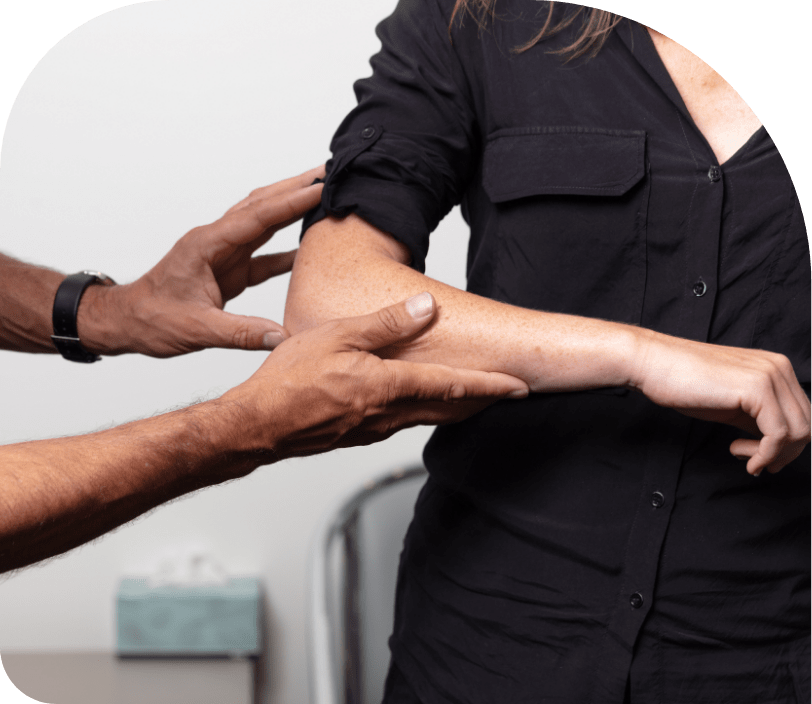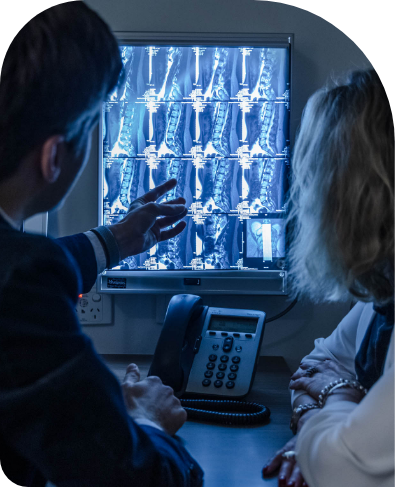Sciatica And Arm Pain

Nerves are responsible for communication between our brains and the rest of our bodies. Sensory nerves send signals, such as pain and touch, to the brain (via the spinal cord).
The brain controls muscle movement by sending signals (via the spinal cord) to motor nerves, which supply muscles.
Compression of a nerve can lead to symptoms like pain, numbness, “pins and needles” or muscle weakness.
What is radiculopathy?
The spine is made of multiple bones called vertebrae. The spinal cord is found in a canal in the centre of these vertebrae.
The nerves that supply the body enter the spinal cord between the vertebrae. Where these nerves enter the spinal cord, they are known as nerve roots. When nerve roots are compressed or irritated, they cause symptoms known as radiculopathy.
What causes radiculopathy?
Nerve roots may be compressed by:
- A herniated disc – a bulging of the cushion between two vertebrae.
- Spinal stenosis – narrowing of the spinal canal.
- Bone spurs – excess bone growth around the spine.
- Spondylolisthesis – shifting of a vertebra in the spine.
Nerve root compression may be triggered by an injury or caused by arthritis.
What are the symptoms of radiculopathy in the neck?

Radiculopathy in the neck (cervical radiculopathy) may cause:
- Pain that starts in the neck and radiates down the arm
- “Pins and needles” or numbness of the hand or fingers.
- Weakness of shoulder, arm or hand muscles.
What are the symptoms of radiculopathy in the lower back (sciatica)?
Radiculopathy of the lower back (lumbar region) is relatively common, as this region is especially vulnerable to injury and the strain of ageing.
Lumbar radiculopathy is commonly called sciatica, as it often involves the nerve roots that supply the sciatic nerve. The sciatic nerve is a large nerve that travels from the lower spine into the buttock, and down the back of the leg.
Symptoms of sciatica usually occur on one side of the body, and include:
- Pain. This may feel like a burning sensation in the buttock, or a shooting pain that starts in the lower back and radiates down the buttock and leg.
- Numbness. Numbness or “pins and needles” may occur, typically at the back of the leg.
- Weakness of the leg or foot.
How is radiculopathy treated?
For most patients, neck or back radiculopathy resolves with conservative treatment. GP may prescribe pain medication and physiotherapy.
In some cases, further investigations may be required, such as an MRI scan, and referral to a neurosurgeon. Treatment may include a steroid injection in the area of the inflamed nerve root. This can reduce nerve irritation and relieve the patient’s symptoms.
Surgery may be required for patients who have significant nerve symptoms, or severe pain that does not improve with conservative treatment. Surgery may involve removal of the piece of bone or prolapsing disc that is causing the ongoing nerve irritation.
Is radiculopathy ever an emergency?
In rare cases, radiculopathy may occur together with a condition that requires urgent neurosurgical treatment.
Myelopathy is compression of the spinal cord itself. Symptoms of myelopathy include loss of bladder or bowel function, problems with fine motor control of the hands, and difficulties with walking or balance.
Cauda Equina Syndrome (CES) involves the nerves at the lower end of the spinal canal. CES may cause loss of function in the legs, problems with bowel or bladder function, and loss of sensation in the groin area.
Myelopathy and CES require urgent or emergency care to prevent permanent nerve damage.
